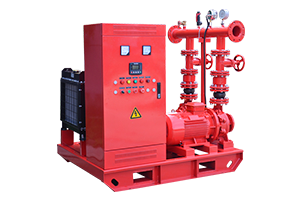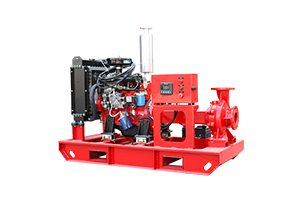How are fire pump sets tested and commissioned?
May 08, 2024
Share:
Testing and commissioning of fire pump sets are critical processes to ensure their proper functionality and reliability in case of emergencies. Here's an overview of how fire pump sets are typically tested and commissioned:
1. **Preparation and Planning**: Before testing and commissioning begin, thorough preparation and planning are necessary. This involves reviewing the design specifications, manufacturer's recommendations, and applicable codes and standards. It also includes coordinating with relevant stakeholders, such as fire protection engineers, contractors, and regulatory authorities.
2. **Visual Inspection**: Conduct a visual inspection of the fire pump sets and associated components to ensure they are installed correctly, securely mounted, and free from any damage or defects. Verify that all piping, valves, controls, and electrical connections are in place and properly labeled.
3. **Hydrostatic Testing**: Perform hydrostatic testing of the fire pump system to verify the integrity of the piping, fittings, and connections. This involves pressurizing the system with water to a specified pressure level and holding it for a designated duration to check for leaks or weaknesses.
4. **Functional Testing**: Conduct functional testing of the fire pump sets to verify their performance under simulated operating conditions. This includes:
- Testing the starting sequence and operation of the pump(s), motor(s), and associated control panel(s).
- Checking the flow rate, pressure, and duration of water discharge from the fire pump system to ensure they meet the required standards.
- Testing the operation of auxiliary components, such as alarms, pressure switches, valves, and monitoring devices.
- Verifying the synchronization and coordination of multiple pumps, if applicable.
- Conducting performance tests at various loads to ensure the system meets specified requirements under different operating scenarios.
5. **Electrical Testing**: Perform electrical testing of the fire pump's electrical components, including the motor, control panel, power supply, and emergency power source (if applicable). This ensures that all electrical connections are secure, and the system operates safely and reliably.
6. **Documentation and Certification**: Document the results of the testing and commissioning processes, including test procedures, test reports, as-built drawings, and equipment manuals. Obtain necessary certifications and approvals from regulatory authorities or third-party inspection agencies to demonstrate compliance with relevant standards and regulations.
7. **Training**: Provide training to personnel responsible for operating and maintaining the fire pump sets. Ensure they understand the system's operation, maintenance requirements, and emergency procedures.
8. **Final Acceptance**: Once testing and commissioning are completed satisfactorily, obtain final acceptance from the project stakeholders, including the client, engineers, and authorities having jurisdiction.
By following these steps, fire pump sets can be properly tested and commissioned to ensure they are reliable and effective in protecting life and property from fire hazards.

1. **Preparation and Planning**: Before testing and commissioning begin, thorough preparation and planning are necessary. This involves reviewing the design specifications, manufacturer's recommendations, and applicable codes and standards. It also includes coordinating with relevant stakeholders, such as fire protection engineers, contractors, and regulatory authorities.
2. **Visual Inspection**: Conduct a visual inspection of the fire pump sets and associated components to ensure they are installed correctly, securely mounted, and free from any damage or defects. Verify that all piping, valves, controls, and electrical connections are in place and properly labeled.
3. **Hydrostatic Testing**: Perform hydrostatic testing of the fire pump system to verify the integrity of the piping, fittings, and connections. This involves pressurizing the system with water to a specified pressure level and holding it for a designated duration to check for leaks or weaknesses.
4. **Functional Testing**: Conduct functional testing of the fire pump sets to verify their performance under simulated operating conditions. This includes:
- Testing the starting sequence and operation of the pump(s), motor(s), and associated control panel(s).
- Checking the flow rate, pressure, and duration of water discharge from the fire pump system to ensure they meet the required standards.
- Testing the operation of auxiliary components, such as alarms, pressure switches, valves, and monitoring devices.
- Verifying the synchronization and coordination of multiple pumps, if applicable.
- Conducting performance tests at various loads to ensure the system meets specified requirements under different operating scenarios.
5. **Electrical Testing**: Perform electrical testing of the fire pump's electrical components, including the motor, control panel, power supply, and emergency power source (if applicable). This ensures that all electrical connections are secure, and the system operates safely and reliably.
6. **Documentation and Certification**: Document the results of the testing and commissioning processes, including test procedures, test reports, as-built drawings, and equipment manuals. Obtain necessary certifications and approvals from regulatory authorities or third-party inspection agencies to demonstrate compliance with relevant standards and regulations.
7. **Training**: Provide training to personnel responsible for operating and maintaining the fire pump sets. Ensure they understand the system's operation, maintenance requirements, and emergency procedures.
8. **Final Acceptance**: Once testing and commissioning are completed satisfactorily, obtain final acceptance from the project stakeholders, including the client, engineers, and authorities having jurisdiction.
By following these steps, fire pump sets can be properly tested and commissioned to ensure they are reliable and effective in protecting life and property from fire hazards.







